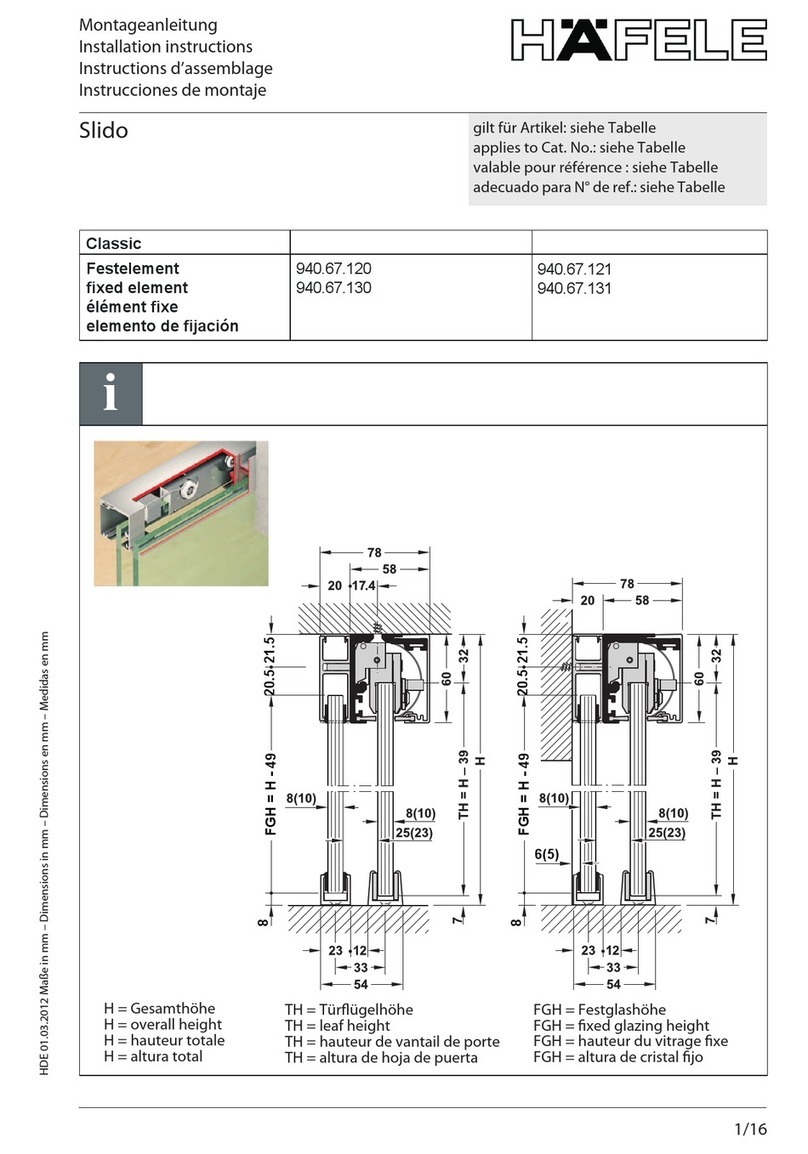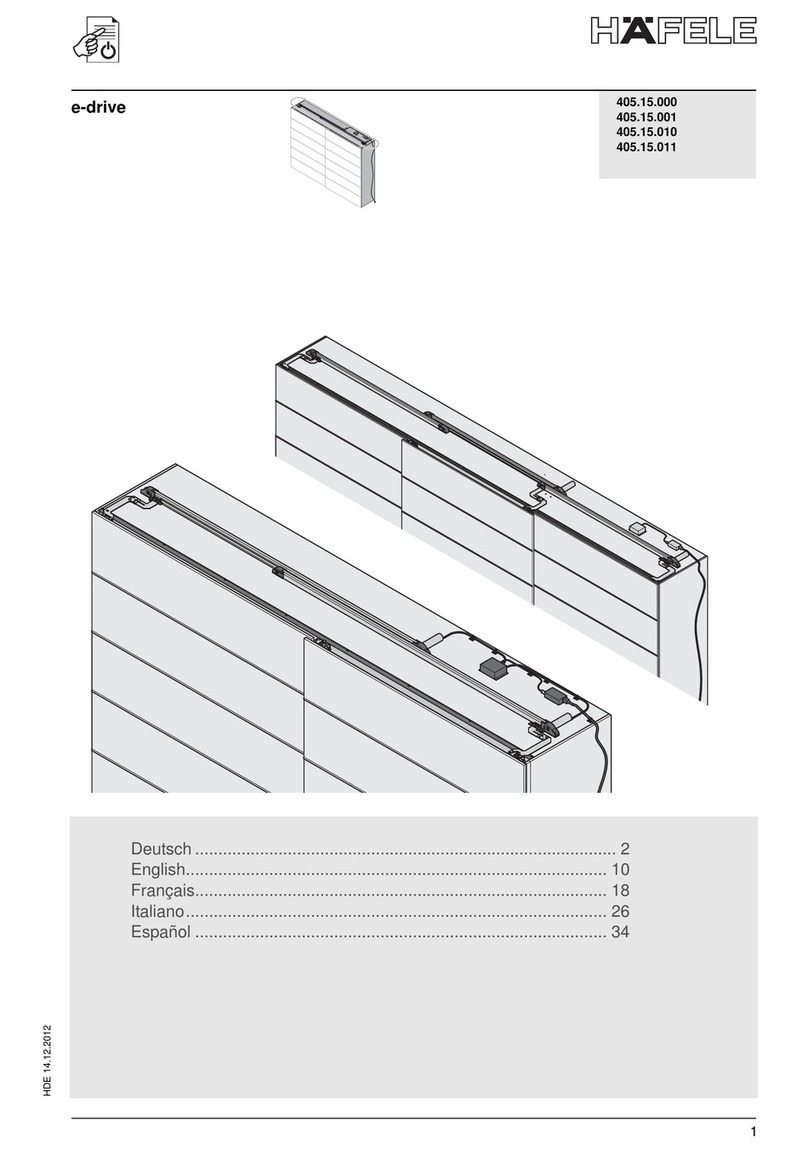ALLGEMEINE SICHERHEITSHINWEISE MASCHINENRICHTLINIE
Gemäß Maschinenrichtlinie (98/37/EG) ist der Installateur, der eine
Tür oder ein Tor motorisiert, den gleichen Verpflichtungen unterle -
gen wie ein Maschinenhersteller und hat somit folgendes zu tun:
- Erstellung der technischen Akte, welche die in Anlage V der
MR genannten Dokumente enthalten muß; (die technische
Akte ist aufzubewahren den nationalen Behörden minde -
stens zehn Jahre lang zur Verfügung zu halten. Diese Frist
beginnt mit dem Herstellungsdatum der motorisierten Tür);
- Aufsetzen der CE-Übereinstimmungserklärung gemäß An -
lage II-A der MR und sie dem Kunden liefern;
- Anbringung der CE-Kennzeichnung an die motorisierte Tür
laut Punkt 1.7.3. der Anlage I der MR.
HINWEISE ZUM GEBRAUCH
Betriebsklasse: 3 (mindestens 30 Zyklen täglich für 10 Jahre
oder 60 Zyklen täglich für 5 Jahre)
Gebrauch: HÄUFIG (für Mehrfamilien-Eingänge oder kleinere
Eigentumsgemeinschaften)
- Die effektiven Betriebsleistungen beziehen sich auf das
empfohlene Gewicht (2/3 des zulässigen Höchstgewichtes).
Die Verwendung mit dem zulässigen Höchstgewicht kann
die oben angegebenen Betriebsleistungen mindern.
- Die Betriebsklasse, die Betriebszeiten und die Anzahl aufein -
anderfolgender Zyklen sind Richtwerte. Sie wurden mit Hilfe
statistischer Verfahren unter normalen Betriebsbedingungen
ermittelt und können im Einzelfall abweichen. Die Werte beziehen
sich auf den Zeitraum, in dem das Produkt funktionsfähig ist,
ohne daß außerordentliche Wartungsarbeiten erforderlich sind.
-
Jede Automatikanlage weist veränderliche Faktoren auf: Reibung,
Ausgleichvorgänge sowie Umweltbedingungen können sowohl die
Lebensdauer als auch die Qualität der Funktionweise der
Automatikanlage oder einer ihrer Komponenten (wie z.B. die
Automatiksysteme) grundlegend ändern. Es ist Aufgabe des
Installationstechnikers, für die einzelne Situation entsprechende
Sicherheitskoeffizienten vorzusehen.
Diese Montageanleitungen sind ausschließlich dem
Fachpersonal vorbehalten.
Die Montage, elektrischen Anschlüsse und Einstellungen sind
unter Beachtung der praktischen Verhaltensregeln und Einhaltung
der geltenden Normen auszuführen.
Lesen Sie die Anleitungen vor der Montage des Produkts
aufmerksam durch. Eine fehlerhafte Montage kann zu ernsthaften
Verletzungen und Sachschäden führen.
Die Verpackungsmaterialien (Kunststoff, Styropor etc.) müssen
sachgemäß entsorgt werden und dürfen nicht in Kinderhände
gelangen, da sie eine Gefahrenquelle darstellen können.
Überprüfen Sie das Produkt vor der Montage auf Transportschä-
den.
Montieren Sie das Produkt nicht in explosionsfähiger Atmosphäre
oder Umgebung: Das Vorhandensein von entzündlichen Gasen
oder Dämpfen bedeutet eine große Gefahr.
Nehmen Sie vor der Montage des Antriebs alle Veränderungen an
der Struktur für die lichten Sicherheitsräume und den Schutz bzw.
die Abtrennung aller Quetsch-, Scher-, Einzieh- und allgemeiner
Gefahrenstellen.
Stellen Sie sicher, dass die vorhandene Struktur den nötigen
Anforderungen im Hinblick auf Robustheit und Stabilität entspricht.
Der Hersteller des Antriebs schließt eine Haftungsübernahme im
Falle der Nichtbeachtung der praktischen Verhaltensregeln bei der
Fertigung der zu motorisierenden Türflugel sowie von während des
Gebrauchs auftretenden Verformungen aus.
Beachten Sie bei der Montage der Schutzeinrichtungen
(Lichtschranken, Kontaktleisten, Not-Stopps etc.) unbedingt die
geltenden Normen und Richtlinien, die Kriterien der praktischen
Verhaltensregeln, die Montageumgebung, die Betriebslogik des
Systems und die von der motorisierten Tür entwickelten Kräfte.
Die Schutzeinrichtungen müssen mögliche Quetsch-, Scher-,
Einzieh- und allgemeine Gefahrenstellen der motorisierten Tür
sichern. Bringen Sie die von den geltenden Vorschriften vorgese-
henen Warn- und Hinweiszeichen zur Kennzeichnung von
Gefahrenstellen an.
Bei jeder Installation müssen die Identifikationsdaten der motori-
sierten Tür an sichtbarer Stelle angebracht werden.
Eingriffe an den elektronischen Geräten dürfen nur mit
antistatischem geerdeten Armschutz vorgenommen
werden.
Der Hersteller des Antriebs lehnt jede Haftung für die Installation
von sicherheits- und betriebstechnisch ungeeigneten Bauteilen ab.
Bei Reparaturen oder Austausch der Produkte dürfen ausschließ-
lich Original-Ersatzteile verwendet werden. Der Monteur ist
verpflichtet, dem Betreiber der Anlage alle erforderlichen Informati-
onen zum automatischen, manuellen und Notbetrieb der motori-
sierten Tür zu liefern und die Betriebsanleitung auszuhändigen.
Stellen Sie vor dem elektrischen Anschluss sicher, dass
die Angaben auf dem Datenschild mit den Werten des
Stromnetzes übereinstimmen.
Statten Sie das Versorgungsnetz mit einem allpoligen Trennschal-
ter mit Kontaktöffnungsabstand von mindestens 3 mm aus. Stellen
Sie sicher, dass der elektrischen Anlage ein geeigneter
Fehlerstrom-Schutzschalter und ein Überstromschutz vorgeschal-
tet sind.
Schließen Sie die motorisierte Tür soweit erforderlich an eine
normgerechte Erdungsanlage an.
Unterbrechen Sie während der Montage-, Wartungs- oder
Reparaturarbeiten die Stromzufuhr, bevor Sie den Deckel für den
Zugang zu den elektrischen Geräten öffnen.






























